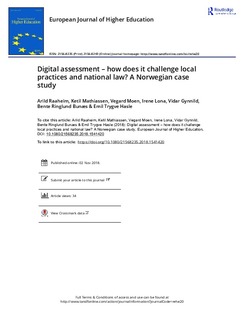| dc.contributor.author | Raaheim, Arild | |
| dc.contributor.author | Mathiassen, Ketil | |
| dc.contributor.author | Moen, Vegard | |
| dc.contributor.author | Lona, Irene | |
| dc.contributor.author | Gynnild, Vidar | |
| dc.contributor.author | Bunæs, Bente Ringlund | |
| dc.contributor.author | Hasle, Emil Trygve | |
| dc.coverage.spatial | Norway | nb_NO |
| dc.date.accessioned | 2019-05-15T12:42:17Z | |
| dc.date.available | 2019-05-15T12:42:17Z | |
| dc.date.created | 2018-11-03T16:35:12Z | |
| dc.date.issued | 2018-11 | |
| dc.identifier.citation | Raaheim, A., Mathiassen, K., Moen, V. et al (2019) Digital assessment – how does it challenge local practices and national law? A Norwegian case study. European Journal of Higher Education. 9(2), pp. 219-231. | nb_NO |
| dc.identifier.issn | 2156-8235 | |
| dc.identifier.uri | http://hdl.handle.net/11250/2597712 | |
| dc.description.abstract | The traditional exam has a strong holding within Norwegian higher education and is very often the preferred way of assessing students. Digital technology opens up for alternatives to the traditional exam, but so far focus has predominantly been on exchanging pen and paper with personal computers within the traditional framework. Digital alternatives may come in conflict with existing law governing teaching and assessment at university, as the law was written at a time when digital technology did not exist. We present data from a workshop in which 48 individuals from 11 institutions, academics as well as administration, were asked to identify and discuss challenges related to the introduction of digital alternatives. A case study strategy was considered appropriate as this gave us the opportunity to collect information from representatives from many universities and university colleges across Norway. Lack of knowledge about alternatives to the traditional exam, and lack of knowledge as to how digital technology may be used in assessing students were the kind of challenges most often mentioned. Assessment practices may be rooted in an assessment policy, but data from a survey (29% response rate) indicate that there is little awareness concerning this issue within Norwegian higher education institutions. | nb_NO |
| dc.language.iso | eng | nb_NO |
| dc.publisher | Taylor & Francis | nb_NO |
| dc.rights | Attribution-NonCommercial-NoDerivatives 4.0 Internasjonal | * |
| dc.rights.uri | http://creativecommons.org/licenses/by-nc-nd/4.0/deed.no | * |
| dc.subject | høyere utdanning | nb_NO |
| dc.subject | digital vurdering | nb_NO |
| dc.subject | utdanningsvitenskap | nb_NO |
| dc.subject | digital teknologi | nb_NO |
| dc.subject | eksamen | nb_NO |
| dc.title | Digital assessment – how does it challenge local practices and national law? A Norwegian case study | nb_NO |
| dc.type | Journal article | nb_NO |
| dc.type | Peer reviewed | nb_NO |
| dc.description.version | publishedVersion | nb_NO |
| dc.rights.holder | © 2018 The Author(s). | nb_NO |
| dc.subject.nsi | VDP::Social science: 200::Education: 280 | nb_NO |
| dc.source.pagenumber | 13 | nb_NO |
| dc.source.journal | European Journal of Higher Education | nb_NO |
| dc.identifier.doi | 10.1080/21568235.2018.1541420 | |
| dc.identifier.cristin | 1626614 | |
| cristin.unitcode | 217,6,0,0 | |
| cristin.unitname | Fakultet for utdanningsvitenskap og humaniora | |
| cristin.ispublished | true | |
| cristin.fulltext | original | |
| cristin.qualitycode | 1 | |

